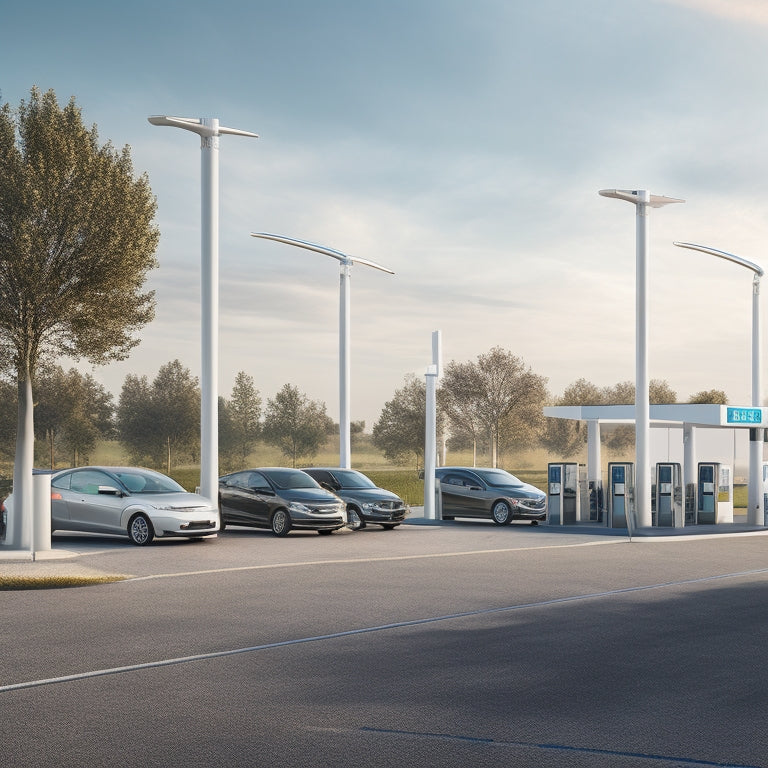
Why Optimal Station Design Matters for EV Fleets
Share
When designing EV charging stations for your fleet, essential design is key. Limited charging points increase downtime, and inefficient layouts waste space, reducing capacity. Slow charging speeds hinder operations, and poor cable management causes hazards. Inadequate queueing systems lead to long wait times, and insufficient power output limits your fleet's capabilities. Additionally, inconvenient station locations, limited access for large vehicles, and non-compliance with safety regulations can further disrupt operations. By understanding these critical factors, you'll be able to identify potential bottlenecks and uncover opportunities to maximize your fleet's productivity, and discover how key station design can revolutionize your EV fleet operations.
Key Takeaways
• Optimal station design maximizes fleet utilization by minimizing downtime and prioritizing vehicles based on battery levels.
• Inefficient station layouts reduce capacity, highlighting the importance of strategic charger placement and urban planning.
• Slow charging speeds reduce fleet productivity, emphasizing the need for optimized charging infrastructure to minimize downtime.
• Poor cable management poses safety hazards, making clear floor clearance and regular inspections essential for accident prevention.
• Real-time monitoring capabilities are crucial for optimizing operations, as data visibility gaps hinder efficiency and lead to inefficient charging patterns.
Limited Charging Points Increase Downtime
With a limited number of charging points, your electric vehicle (EV) fleet is likely to experience increased downtime, as vehicles wait in queue for an available charging slot, reducing overall operational efficiency.
This bottleneck can be mitigated by implementing smart Charging Strategies that prioritize vehicles based on their battery levels, ensuring the most critical ones are serviced first. Effective Fleet Prioritization is key to minimizing downtime and maximizing fleet utilization.
Inefficient Station Layout Wastes Space
As you design your EV fleet station, you'll quickly realize that inefficient layouts can waste valuable space, reducing your station's overall capacity.
You'll identify space constraints that hinder your ability to accommodate more chargers or vehicles, and notice inadequate charger placement that slows down the charging process.
Space Constraints Identified
Frequently, inefficient station layouts lead to wasted space, resulting in reduced charging capacity and increased operational costs. As you design your EV fleet's charging station, it's essential to consider urban planning and parking strategies to maximize space usage.
Some common space constraints to identify include:
- Narrow aisles and inadequate clearance between chargers
- Poorly positioned electrical infrastructure
- Inadequate cable management systems
- Insufficient space for future charger upgrades or expansion
- Inefficient use of vertical space, resulting in wasted square footage
This understanding is crucial for ensuring optimal efficiency and scalability in your EV charging infrastructure. By addressing these space constraints early in the design phase, you can create a more streamlined and cost-effective charging station that meets the needs of your growing fleet.
Inadequate Charger Placement
When designing your EV fleet's charging station, you'll often find that inadequate charger placement is a major contributor to wasted space, as chargers are frequently installed without considering the overall station layout. This oversight can lead to reduced charger reliability, increased maintenance costs, and decreased overall efficiency.
Urban planning principles should be applied to optimize charger placement, ensuring a logical and efficient layout that minimizes congestion and maximizes space utilization. By prioritizing charger placement, you can create a more efficient and reliable charging experience for your EV fleet, ultimately reducing downtime and increasing productivity.
Poor Traffic Flow
In a poorly designed charging station, you'll often find that inefficient traffic flow hinders the entire operation, wasting valuable space and reducing overall productivity. A well-designed layout should prioritize traffic flow, ensuring a seamless experience for your EV fleet.
To achieve this, conduct a thorough flow analysis to identify bottlenecks and optimize traffic patterns.
Some key considerations for efficient traffic flow include:
- Identifying peak usage periods to manage congestion
- Designating specific lanes for different types of vehicles
- Implementing a one-way traffic system to reduce congestion
- Providing ample space for vehicles to maneuver
- Strategically placing chargers to minimize queuing
Slow Charging Speeds Hinder Operations
Slow charging speeds greatly impede your EV fleet's operational efficiency, as vehicles remain idle for extended periods, waiting for a full charge. This downtime translates to reduced fleet productivity, directly impacting your bottom line.
Charging inefficiencies are a significant obstacle to overcome, as they hinder your ability to maximize vehicle utilization. With slow charging speeds, you're forced to allocate more resources to manage the same workload, increasing operational costs.
To regain control, it's essential to optimize your charging infrastructure. By doing so, you can minimize downtime, reduce costs, and boost fleet productivity.
Poor Cable Management Causes Hazards
When designing your EV fleet's charging station, it's essential to prioritize cable management to avoid hazards that can put your operations at risk.
Poorly managed cables can create tripping hazards, causing slips, trips, and falls that can lead to injuries and downtime.
Additionally, exposed or damaged cables can also lead to electrical shock dangers, which can be fatal if not addressed promptly.
Tripping Hazard Risks
Poor cable management can trip you up, literally, by creating a hazardous web of cords and wires that can lead to accidents and downtime in your EV fleet's station. To avoid this, it's important to prioritize cable routing and maintain a clear floor clearance.
Here are some essential considerations to keep in mind:
-
Make sure cables are neatly organized and secured to walls or ceilings to prevent snagging or tangling.
-
Label cables clearly to facilitate easy identification and maintenance.
-
Designate specific zones for charging cables to keep them organized and easily accessible.
-
Implement cable management systems, such as cable ties or clips, to keep cords tidy.
-
Regularly inspect and maintain cables to prevent damage or wear that can lead to tripping hazards.
Electrical Shock Dangers
When you neglect to properly manage cables, you're not only creating tripping hazards, but also risking electrical shock, which can be deadly.
Poor cable management can lead to electrical shock, arc flash risks, and even fatalities. As you design your EV charging station, it's essential to implement electrical safety protocols to prevent these hazards.
Guarantee cables are securely fastened, neatly organized, and protected from damage. This not only reduces the risk of electrical shock but also minimizes downtime and maintenance costs.
Inadequate Vehicle Queueing Systems
Inefficient queueing systems at EV charging stations often result in long wait times, reducing the overall productivity of your fleet operations. This can lead to decreased efficiency, increased costs, and a negative impact on your bottom line.
To avoid these issues, it's essential to implement effective queue management strategies and vehicle prioritization methods. Consider the following:
- Implementing a queuing system that allows for real-time monitoring and adjustment of charging schedules
- Prioritizing vehicles based on their charging needs and deadlines
- Allocating charging stations to specific vehicles or groups
- Implementing a dynamic pricing strategy to manage demand
- Utilizing data analytics to optimize queue management and reduce wait times
Lack of Real-Time Monitoring Capabilities
As you design your EV fleet's station, you'll soon realize that a lack of real-time monitoring capabilities can hinder your operations.
You need to make certain that you have a system in place that provides complete data visibility, eliminating gaps that can lead to inefficiencies and downtime.
Data Visibility Gaps
You may be surprised to discover that your EV fleet's performance is hindered by a lack of real-time monitoring capabilities, creating data visibility gaps that can lead to inefficient charging and reduced overall efficiency. Without real-time data, you're left with information silos, making it difficult to gain actionable data insights.
This lack of visibility can lead to inefficient charging patterns, resulting in reduced overall efficiency. Additionally, it can result in unidentified issues with charging stations, leading to downtime and lost productivity. Inaccurate energy consumption tracking can make it difficult to optimize energy usage, while limited visibility into fleet performance hinders data-driven decision-making.
Moreover, the inability to identify areas for improvement can lead to stagnated growth and reduced competitiveness.
Inadequate Alert Systems
Your EV fleet's charging station is only as reliable as its alert system. Inadequate alert systems can have far-reaching consequences, including prolonged downtime and unnecessary maintenance costs. Without real-time monitoring capabilities, manual checks lead to alert fatigue. This can result in critical issues going unnoticed, causing devastating system downtime for your operations.
A well-designed alert system should provide instant notifications of any issues, allowing prompt action. Real-time monitoring ensures you receive targeted alerts, reducing the likelihood of alert fatigue and ensuring swift issue resolution.
Don't compromise your fleet's efficiency with inadequate alert systems. Prioritize a reliable alert system to minimize downtime and maximize productivity.
Insufficient Power Output for Fleets
Insufficient power output from charging stations can severely limit the operational capacity of electric vehicle (EV) fleets, necessitating a thorough examination of station design to guarantee peak performance.
As you design your EV fleet's charging infrastructure, it's essential to take into account the power demand of your vehicles. If your charging stations can't keep up with your fleet's energy needs, you'll face reduced fleet capacity and decreased productivity.
Some key factors to take into account when designing your charging station include:
- The number of vehicles that need to be charged simultaneously
- The power output required to meet your fleet's energy demands
- The type of charging connectors and cables needed
- The electrical infrastructure required to support high-power charging
- The potential for future expansion and scalability
It is crucial to consider these factors comprehensively to ensure that your EV fleet's charging infrastructure can support its operational requirements effectively.
Station Location Inconvenient for Drivers
A poorly situated charging station can greatly disrupt fleet operations, as drivers waste valuable time and resources finding their way to and from inconveniently located charging points. You can't afford to overlook the importance of station location in meeting driver expectations.
Urban planning principles should be applied to guarantee that charging infrastructure is strategically positioned, taking into account traffic patterns, road networks, and land use. By doing so, you can minimize detours, reduce congestion, and optimize route efficiency.
In addition, well-designed station locations can improve safety, reduce stress, and enhance the overall driver experience. By prioritizing station location, you can create a seamless charging experience that aligns with your fleet's operational needs.
Limited Access for Large Vehicles
Large fleet vehicles, such as buses and trucks, often struggle to access charging stations designed with smaller vehicles in mind, resulting in frustrating delays and decreased productivity. When designing your EV fleet's charging infrastructure, it's crucial to take into account the unique needs of larger vehicles. Here are some key factors to bear in mind:
-
Vehicle clearance: Guarantee the station's canopies or overhead structures don't obstruct larger vehicles' access to charging points.
-
Turning radius: Plan the station's layout to accommodate the wider turning radius of larger vehicles.
-
Charging point placement: Position charging points to allow for easy access and maneuverability.
-
Aisle width: Ensure the station's aisles are wide enough to accommodate larger vehicles' width and length.
-
Site grading: Make sure the station's terrain is graded to accommodate larger vehicles' weight and size.
Non-Compliance With Safety Regulations
When designing your EV fleet's charging infrastructure, you must make sure that your station adheres to safety regulations to avoid accidents and costly fines. Non-compliance can lead to serious consequences, including electrical shock, fire hazards, and even fatalities. Regulatory oversight is essential to guarantee that your station meets the necessary safety protocols.
Failure to adhere can result in penalties, lawsuits, and damage to your reputation. You must consider factors such as electrical safety, fire suppression systems, and emergency response plans. Implementing robust safety protocols won't only protect your fleet and personnel but also minimize downtime and reduce liability.
Don't risk it – prioritize compliance to ensure a safe and efficient charging operation.
Frequently Asked Questions
How Do I Prioritize Charger Allocation for Different Vehicle Types?
To prioritize charger allocation for different vehicle types, you'll need to implement vehicle segmentation, categorizing vehicles by range, charging speed, and power requirements, then allocate chargers based on these categories to optimize charger utilization.
Can I Integrate My Existing Fleet Management System With EV Charging Infrastructure?
You can seamlessly integrate your existing fleet management system with EV charging infrastructure using API integration, enabling real-time data analytics to optimize charging operations, enhance fleet performance, and streamline your EV fleet management.
What Are the Optimal Charger-To-Vehicle Ratios for Efficient Operations?
"As you navigate the EV fleet landscape, remember the wisdom of Goldilocks - not too much, not too little, but just right. Aim for a charger-to-vehicle ratio that balances peak demand with minimal charger downtime, ensuring efficient operations."
How Do I Ensure Consistent Charging Speeds Across All Stations?
To guarantee consistent charging speeds across all stations, you'll want to prioritize charging reliability by implementing station standardization, using identical charger models and configuring them with identical power output settings to minimize variability.
Are There Any Incentives for Building EV Charging Stations With Optimal Design?
As you expand your EV charging network, you'll be pleased to discover that government grants and tax credits are available to incentivize building stations with efficient design, saving you money and promoting sustainability.
Related Posts
-

What Do Power Strips Do for Standby Energy?
You're likely aware that your devices, such as TVs and computers, continue to draw power even when turned off, a phen...
-

Why Choose Solar Composting Toilets for Your Home?
By choosing a solar composting toilet for your home, you'll greatly reduce your environmental impact, slashing your w...
-

10 Powerful Electric Mowers for Expansive Lawns
You're moving away from gas-powered mowers and exploring electric options for your expansive lawn. You'll find that h...


